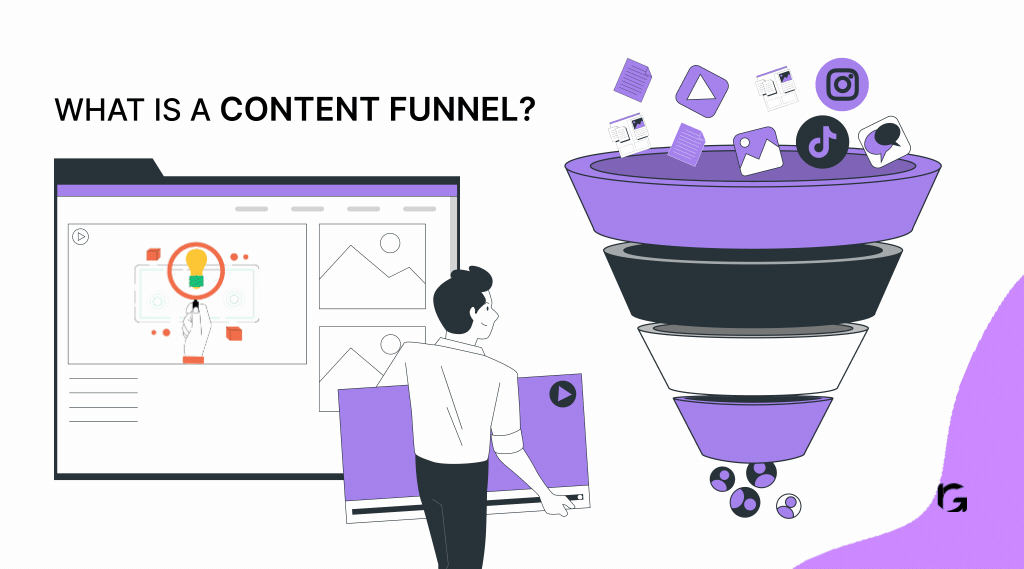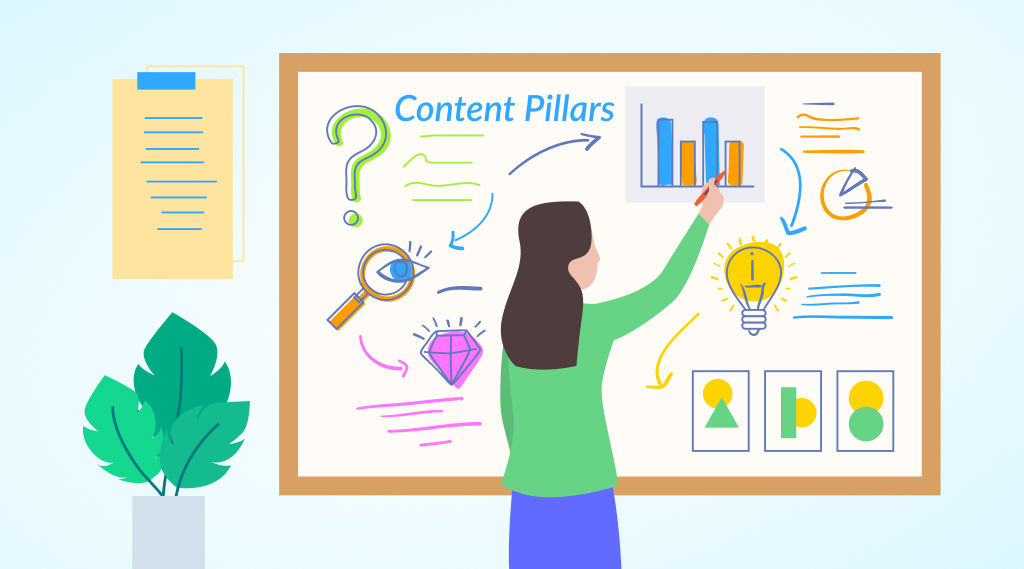Introduction
Generating leads can be overwhelming, can’t it? In 2024, mastering the art of content funnels is more important than ever. With competition for consumer attention at an all-time high, you need a strategy that not only captures leads but also nurtures and converts them into loyal customers.
A well-structured content funnel is like a roadmap for your customer’s journey, guiding them from their first interaction with your brand to purchasing. This guide will walk you through the essential stages and strategies for building a successful content funnel. By the end, you’ll know precisely how to boost your leads and conversions.
Ready to get started? Download our detailed content funnel template and see your marketing strategies improve dramatically!
What is a content funnel?
Imagine a funnel in your kitchen—wide at the top and narrow at the bottom. A content funnel works the same way. It starts by attracting a broad audience at the top and gradually guides the most interested prospects down to make a purchase. In digital marketing, a content funnel helps you organize and create content that moves potential customers through different stages: awareness, consideration, and decision.
The goal is to provide the right content at the right time, making it easier for your audience to learn about your brand, understand its value, and eventually become loyal customers. This structured approach ensures that your marketing efforts are efficient and effective, ultimately boosting your leads and conversions.
Content funnel stages
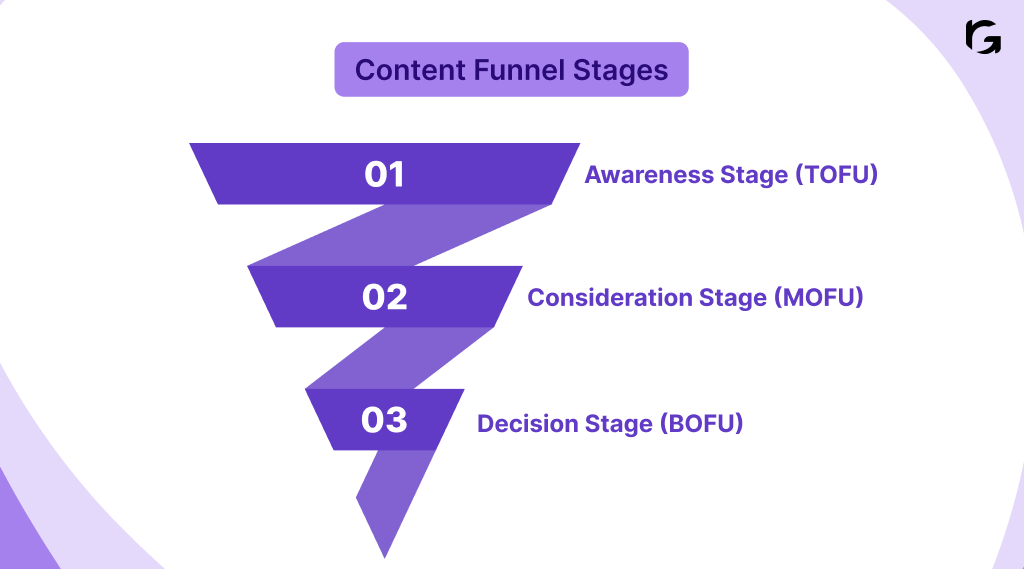
- Awareness stage (TOFU)
- Consideration stage (MOFU)
- Decision Stage (BOFU)
Awareness stage (TOFU)
The top of the funnel, or TOFU, is about making your audience aware of your brand. At this stage, your goal is to attract a broad audience and introduce them to your products or services. Think of it as the first impression—your chance to grab attention and pique interest.
The primary purpose of the awareness stage is to build brand recognition and attract potential leads. At this point, your audience isn’t ready to purchase; they’re just discovering who you are and what you offer.
Types of content
- Blog Posts: Write informative and engaging articles that address common problems or trends in your industry. For example, HubSpot publishes blog posts like “The Top Marketing Trends of 2024 & How They’ve Changed Since 2023 ” to attract marketers looking for the latest insights.
- Social Media: Use platforms like Instagram, TikTok, and LinkedIn to share engaging content. Duolingo, for instance, uses TikTok to create entertaining videos that reach millions, building brand awareness without directly selling their product.
- Webinars: Host webinars to educate your audience about industry-related topics. This positions your brand as an expert and builds trust early on.
- Explainer Videos: Develop short videos that clarify essential concepts or showcase the benefits of your product. These can be shared on social media and your website to attract a wide audience.
- How-to Articles: Provide step-by-step guides on solving common problems. This type of content is highly searchable and attracts visitors looking for specific solutions.
Consideration stage (MOFU)
The middle of the funnel, or MOFU, focuses on nurturing the leads you’ve attracted. At this stage, potential customers are aware of your brand and are considering their options. Your job is to provide them with more in-depth information that helps them evaluate your products or services against competitors.
The MOFU stage is crucial for building relationships and trust. It’s about convincing prospects that your solution fits their needs best. You achieve this by addressing their pain points and showcasing how your product or service can solve their problems.
Types of content
- Webinars: These are excellent for providing detailed information and demonstrating your expertise. Hosting a webinar on “Advanced SEO Strategies” can engage prospects who are serious about improving their SEO efforts.
- Case Studies: Showcasing real-world examples of how your product or service has helped other customers can be persuasive. Salesforce frequently publishes case studies highlighting the impact of its solutions on various businesses.
- Ebooks and Whitepapers: These in-depth resources provide valuable insights and can be gated to collect contact information. An ebook on “The Ultimate Guide to Digital Transformation” can attract decision-makers looking to modernize their operations.
- Email Newsletters: Regular updates with valuable content keep your brand top of mind and nurture the relationship further.
- Product Comparison Guides: Help prospects compare your product with competitors, highlighting your unique advantages and features.
Decision stage (BOFU)
At the bottom of the funnel or BOFU, the focus shifts to conversion. At this point, prospective customers know their choices and assess your product or service to finalize their decision. Your goal is to provide the final push needed to convert these leads into paying customers.
The focus of the BOFU stage is to finalize the sale. It involves addressing any remaining objections, showcasing the value of your offering, and making it easy for prospects to take the next step.
Types of content
- Free Trials: Offering a free trial allows prospects to experience your product firsthand. This is particularly effective for software companies. For example, SaaS platforms like HubSpot offer a free trial period to help potential customers see the value of their services.
- Demos: Offering live or recorded demonstrations can comprehensively overview your product’s features and advantages. Salesforce, for instance, uses personalized demos to show how their CRM can meet specific business needs.
- Customer Testimonials: Real-world success stories from satisfied customers can be very persuasive. Video testimonials or written reviews provide social proof and build trust.
- Detailed Product Information: Comprehensive guides, FAQs, and specification sheets help prospects understand the technical details and benefits of your product.
- Consultations: One-on-one consultations or live chats with sales representatives can address specific concerns and provide personalized solutions.
Strategy for B2B content marketing funnels
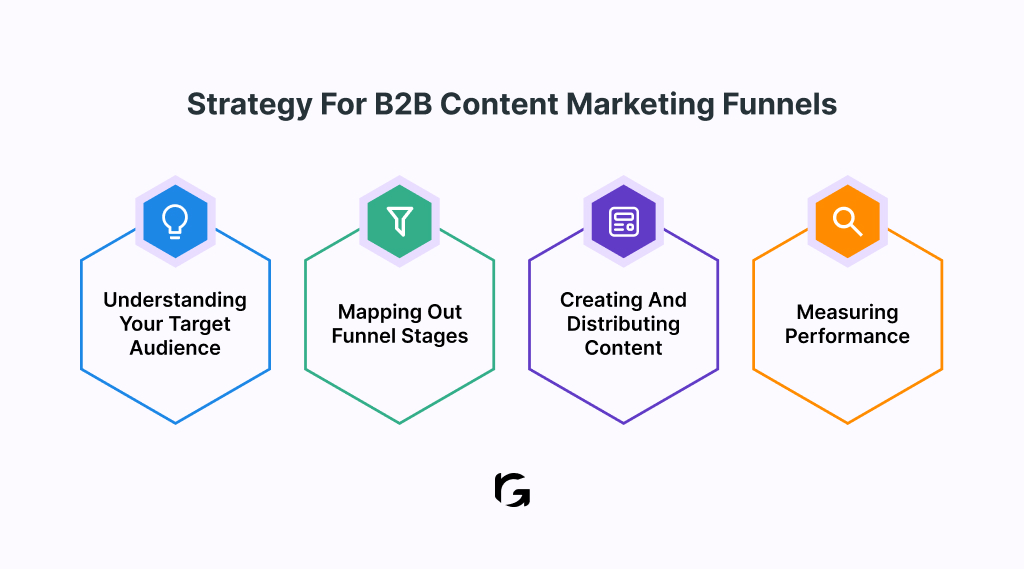
- Understanding your target audience
- Mapping out funnel stages
- Creating and distributing content
- Measuring performance
Understanding your target audience
First, get to know your audience. Define buyer personas and segment them based on their needs and behaviors. For example, a SaaS company like HubSpot uses market research to identify pain points and tailor their content to address these specific issues. This approach helps create more targeted and effective marketing strategies.
Mapping out funnel stages
- TOFU (Top of Funnel)- Create engaging content to attract a wide audience. For instance, HubSpot publishes blog posts on marketing trends and shares infographics on social media. This helps raise brand awareness and draw in potential leads.
- MOFU (Middle of Funnel)- Nurture your leads by offering valuable insights. Salesforce, for example, hosts webinars and shares case studies to help prospects understand how their CRM can solve specific problems. EBooks can also provide in-depth information that aids in the decision-making process.
- BOFU (Bottom of Funnel)- Convert leads into customers by offering free trials, demos, and customer testimonials. A good example of this is Adobe’s free trial for its software.
- These tactics allow potential customers to experience the product first-hand and see its value before purchasing.
Creating and distributing content
Use SEO best practices to create high-quality, personalized content. Distribute your content through various channels, including email, social media, and PPC ads. For example, LinkedIn ads can be particularly effective for targeting B2B audiences with specific interests and job titles.
Measuring performance
Track key metrics such as engagement rates, conversion rates, and customer acquisition costs. Tools like Google Analytics can help you analyze the performance of your content. Understanding these metrics allows you to see what’s working and make informed decisions on where to improve.
Building a content funnel
Building a content funnel might seem complicated, but it’s easier than you think. Let’s break down the steps to create a successful funnel that drives results:
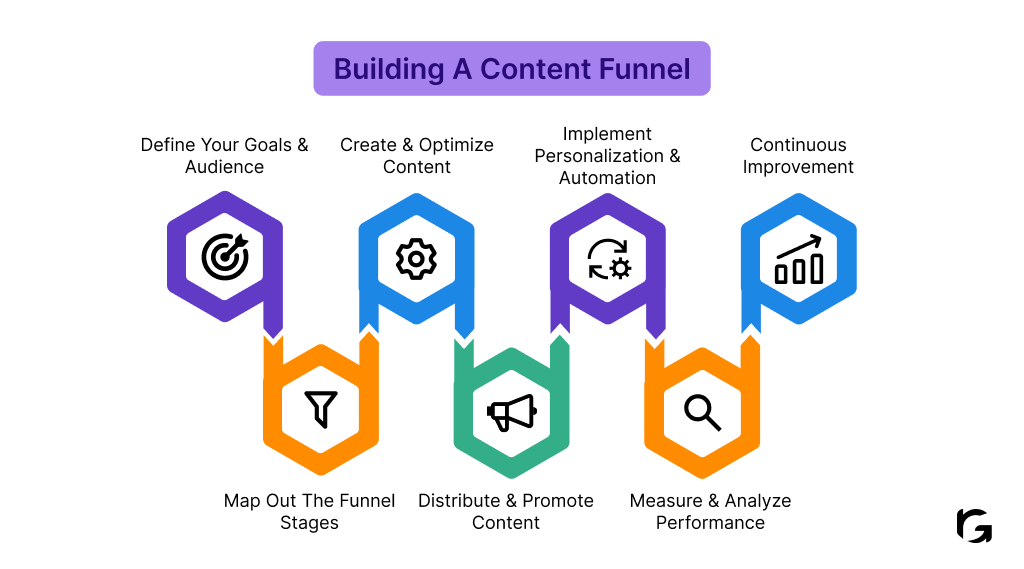
- Define your goals and audience.
- Map out the funnel stages
- Create and optimize content
- Distribute and promote content
- Implement personalization and automation
- Measure and analyze performance
- Continuous improvement
Step 1: Define your goals and audience
Begin with setting your objectives and gaining a clear understanding of your audience. The content funnel template is your best friend here. It helps you clearly outline primary goals like lead generation or conversions. Think of it as a roadmap that keeps your efforts on track.
Step 2: Map out the funnel stages
Mapping out your funnel stages—Awareness (TOFU), Consideration (MOFU), and Decision (BOFU)—is essential. Start by identifying the type of content needed at each stage. For TOFU, focus on creating engaging blog posts and social media content to attract a broad audience. In the MOFU stage, develop webinars and case studies to nurture and educate leads. At the BOFU stage, offer free trials, product demos, and customer testimonials to help convert prospects into customers.
With our Content funnel template, you can strategically plan your blog posts, webinars, and product demos to keep your content focused and impactful.
Step 3: Create and optimize content
Creating high-quality content is all about making it engaging and SEO-friendly. Begin by conducting keyword research to discover what your audience is looking for. Incorporate these keywords naturally into your blog posts to improve your search engine rankings. Create content that meets the needs and interests of your audience. Make sure it’s valuable, informative, and unique. Don’t forget to optimize for on-page SEO by using headers, internal links, and meta descriptions to boost visibility and ranking.
Step 4: Distribute and promote content
Distributing your content effectively requires a multi-channel approach. Plan your email marketing campaigns to keep your audience engaged and nurture leads. Use social media to reach a wider audience and promote your blog posts, webinars, and other content. Pay-per-click (PPC) ads are another effective way to attract targeted traffic to your website. Coordinating your distribution strategy ensures your content reaches the right people through the right channels.
Step 5: Implement personalization and automation
Personalize your content delivery using marketing automation tools. Segment your audience based on their behavior, preferences, and where they are in the buyer’s journey. Send targeted emails and content that address specific needs and interests. Automation tools streamline this process, making your messaging relevant and timely.
Step 6: Measure and analyze performance
Measuring your content’s performance is key to understanding its impact. Track engagement rates, conversion rates, and overall traffic. Use analytics tools to gain insights into user behavior and content effectiveness. Regularly review these metrics to make data-driven decisions and optimize your content strategy.
Step 7: Continuous improvement
Content marketing is an ongoing process. Conduct A/B testing to find the most effective headlines, CTAs, and content formats. Use the insights from your performance metrics to continuously refine your strategy, ensuring your content always meets your audience’s needs.
SaaS content marketing funnel example
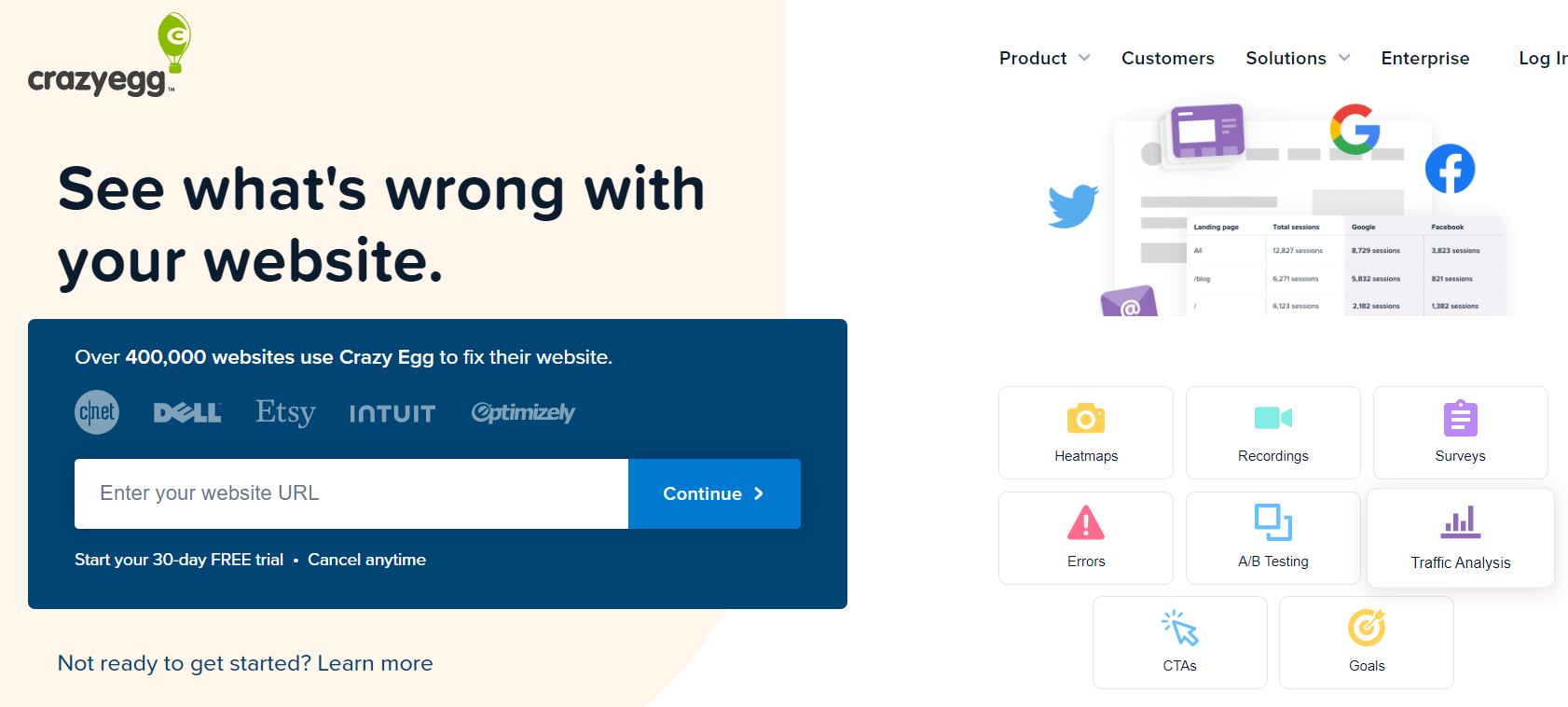
Let’s look at CrazyEgg‘s content funnel.
Awareness Stage (TOFU)
CrazyEgg, a SaaS company that offers heat map tools, starts by grabbing attention through targeted Facebook ads. These ads focus on enticing potential customers who are looking to boost their e-commerce revenue. When users click on these ads, they are directed to engaging blog posts that explain how heat maps can help improve website performance. This strategy not only drives traffic to their site but also introduces a broad audience to CrazyEgg’s solutions.
Consideration Stage (MOFU)
Once CrazyEgg has captured the interest of potential customers, they nurture these leads with interactive and informative content. Visitors to CrazyEgg’s website can enter their URL for a free heat map analysis. This interactive tool shows real-time data on how users interact with their site, demonstrating the value of CrazyEgg’s services firsthand. They also send educational emails and resources to inform further and engage their audience, building trust and keeping their solution top-of-mind.
Decision Stage (BOFU)
When it comes to sealing the deal, CrazyEgg excels by offering precise and compelling calls to action. After users engage with the free heat map analysis, they are guided to a pricing page that outlines different subscription plans. To help nudge these leads into making a decision, they include testimonials from well-known brands and a comprehensive FAQ section that addresses common concerns. For those who aren’t ready to buy immediately, CrazyEgg sends follow-up emails with additional information and support, gently pushing them towards a purchase.
By using targeted ads, interactive content, and personalized follow-ups, CrazyEgg effectively guides prospects through its content funnel. This approach ensures that potential customers receive the right information at the right time, making it easier for them to move from interest to decision, ultimately driving higher conversion rates and business growth.
Conclusion
Mastering content funnels is more than just a marketing strategy; it’s a game-changer for lead generation and business growth. By effectively guiding potential customers through each stage of the funnel, you create a seamless journey that not only attracts and nurtures leads but also converts them into loyal customers. Remember, the key is to provide value at every stage, ensuring your content is relevant and engaging.
One unique insight to consider is the power of integrating feedback loops into your content funnel. By regularly collecting and analyzing customer feedback, you can continually refine and improve your content, making it more responsive to the evolving needs and preferences of your audience.
Ready to transform your marketing efforts with Revvgrowth?
Download our comprehensive content funnel template to build a robust content strategy that drives results. This template provides a structured approach to planning, creating, and optimizing your content, ensuring you stay ahead and grow endlessly.

